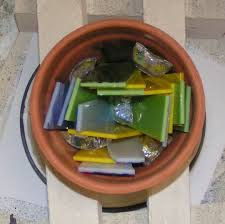A good way to get strong colour separation is to put two colours on opposite sides and a third colour or clear between them. The two side colours will have best separation if they are not more than 1/3 each. As the glass begins to flow out of the pot, all three colours will come out at once and form concentric circles (assuming a circular hole in the pot).
 |
| Vertical stacking of multiple colours |
You can manipulate and alter the results with a fair amount of predictability by changing the diameter and shape of the hole, charging the pot with more than three colours or less, rearranging the orientation into a sunburst orientation or whatever comes to mind. Be sure to keep notes on what you did and what the results were in case you want to reproduce the effect.
Think about how the glass will flow out of the pot when you charge it with glass. If you layer colours horizontally from C (on top) to A (on bottom), it will initially flow out in colour A, then B, then C. After that initial flow, which will be on the outside of the finished piece, the main flow will be from the top (C), then the middle (B) and finally the bottom (A). This is because after the initial flow, the rest of the glass comes out in a funnel shape pulling the top and small portions of the underlying glass.
This means that layering is the best way of mixing colours. You need to think about colour combinations too. For example yellow and red become brown; yellow and blue a dark green, etc.
The proportion of dark colours is important, for example, as little as 2% of black can make the whole piece very dark. If you have dark colours, you need to add a large proportion of clear or very light opalescent glass.
If you use frit, large pieces are better than smaller ones. Even so, you need to be careful about the colours you use so the whole does not become muddy.
No comments:
Post a Comment